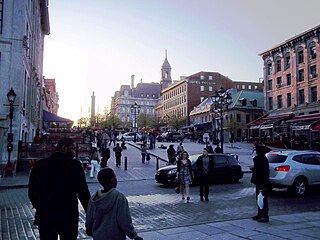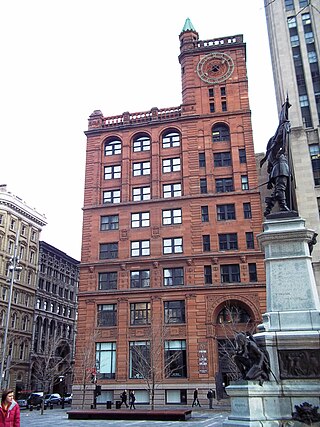
The Molson Bank was a Canadian bank founded in Montreal, Quebec, by brothers William (1793–1875) and John Molson, Jr. (1787–1860), the sons of brewery magnate John Molson.

Place Jacques-Cartier is a square located in Old Montreal, Quebec, Canada. It is an entrance to the Old Port of Montreal.

CIBC Tower is a 187 m (614 ft) 45-storey skyscraper in Montreal, Quebec, Canada. With the communications antenna on the roof, the total height is 225 m (738 ft). The International Style office tower was built by Peter Dickinson, with associate architects Ross, Fish, Duschenes and Barrett, and was the city's tallest building from 1962 to 1963. The building holds offices for the Canadian Imperial Bank of Commerce, the corporate law firm Stikeman Elliott, as well as numerous other businesses.

Old Montreal is a historic neighbourhood within the municipality of Montreal in the province of Quebec, Canada. Home to the Old Port of Montreal, the neighbourhood is bordered on the west by McGill Street, on the north by Ruelle des Fortifications, on the east by rue Saint-André, and on the south by the Saint Lawrence River. Following recent amendments, the neighbourhood has expanded to include the Rue des Soeurs Grises in the west, Saint Antoine Street in the north, and Saint Hubert Street in the east.

Saint Jacques Street, or St. James Street, is a major street in Montreal, Quebec, Canada, running from Old Montreal westward to Lachine.

Saint Denis Street is a major north–south thoroughfare in Montreal, Quebec.

The Bank of Montreal's Head Office is located on 119, rue Saint Jacques in Montreal, Quebec, Canada, across the Place d'Armes from the Notre-Dame Basilica in the Old Montreal neighbourhood. The Bank of Montreal is the oldest bank in Canada, founded in 1817. Although it still remains the bank's legal headquarters, its operational head office was moved to First Canadian Place in Toronto in 1977 due to political instability in Quebec.

Montreal's New York Life Insurance Building is an office building at Place d'Armes in what is now known as Old Montreal, erected in 1887–1889. At the time of its completion, it was the tallest commercial building in Montreal with the first eight floors were designed for retail office space, that quickly filled with the city's best lawyers and financiers. When the clock tower was completed, the owner filled the ninth and tenth floors with the largest legal library in the entire country as a gift to tenants. The building is next to another historic office tower, Aldred Building.

The Royal Bank Tower is a skyscraper at 360 Saint-Jacques Street in Montreal, Quebec. The 22-storey 121 m (397 ft) neo-classical tower was designed by the firm of York and Sawyer with the bank's chief architect Sumner Godfrey Davenport of Montreal. Upon completion in 1928, it was the tallest building in the entire British Empire, the tallest structure in all of Canada and the first building in the city that was taller than Montréal's Notre-Dame Basilica built nearly a century before.
The Canadian Imperial Bank of Commerce Building is a building at 265 Saint-Jacques Street in Montreal, Quebec, Canada.

Peel Street (officially in French: rue Peel) is a major north–south street located in downtown Montreal, Quebec, Canada. The Street links Pine Avenue, near Mount Royal, in the north and Smith Street, in the Southwest borough, in the south. The street's southern end is at the Peel Basin of the Lachine Canal. The street runs through Montreal's shopping district. The Peel Metro station is named for the street.
Stanley Street is a north–south street located in downtown Montreal, Quebec, Canada. It links Doctor Penfield Avenue in the north and De la Gauchetière Street in the south. Molson's Bank was located on the street and at one time employed Joachim von Ribbentrop.

Saint Antoine Street, formerly known as Craig Street, is a street located in Montreal, Quebec, Canada. It runs to the south of Downtown Montreal and north of Old Montreal and Griffintown and Saint-Henri. It crosses the Quartier international de Montréal. Between Atwater Avenue and Greene Avenue, the north side of the street is in Westmount.

The Aldred Building is an Art deco building on the historic Place d'Armes square in the Old Montreal quarter of Montreal, Quebec, Canada.

Dalhousie Station is a former railway station in Montreal, Quebec, Canada. Built in 1884, the building stands at the corner of Notre-Dame Street and Berri Street in what is now Old Montreal. The oldest surviving railway station building in Montreal, Dalhousie Station was named after George Ramsay, 9th Earl of Dalhousie, who was Governor General of Canada from 1825 to 1828.

Édifice Ernest-Cormier was the second courthouse in Montreal to bear the name Palais de justice de Montréal. It was built between 1922 and 1926, and designed by architects Louis-Auguste Amos, Charles Jewett Saxe and Ernest Cormier. It was the first major commission for Cormier after his return to Montreal from his studies in Paris. After Cormier's death in 1980, the building was renamed in his honour. It currently houses the Quebec Court of Appeal.

The Place d'Youville in Old Montreal is a historical square in Montreal, named after Marguerite d'Youville. The roads from the Place Royale and McGill Street meet at this point. The square is notable as the site of St. Anne's Market, a market building that once housed the Legislative Council and Assembly of Canada between 1844 and 1849, when it was burned down on April 25, 1849.

The Montreal Star Building is a former office complex, now hotel, in Montreal, Quebec, Canada. The complex, which is located in Old Montreal is composed of three different attached buildings belonging to the Montreal Star newspaper.

The Centre d'histoire de Montréal is a museum in Montreal, Quebec, Canada. It is located at 335 Place d'Youville in Old Montreal, in the borough of Ville-Marie. The museum is dedicated to the history of Montreal.

The Crown Trust Company was an Ontario-based firm that operated in most of Canada prior to its bankruptcy, along with several other trusts, in 1983. The bankruptcies occurred when a major Canadian recession drove down speculative real estate values into which the trusts had made increasingly bad loans during a period of rising inflation and interest rates. Crown Trust, and many other Canadian financial institutions, were left with an overwhelming volume of defaulted mortgages.


















